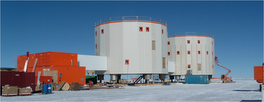Sunday seismometer #4
Wiechert vertical seismograph (1909)
The Wiechert vertical seismograph was built in Göttingen, Germany, in 1909, five years after the horizontal seismograph described in last week's post. The two instruments together formed a complete recording system, capable of determining the 3 components of ground motion.
The vertical seismograph has a mass of 1200 kg and a natural period of 5 seconds. Its design is more immediately recognizable by today's high-school students, as it is essentially a damped mass on a spring.
In order to reduce the temperature variations inside the instrument, which change the mechanical properties of the springs, the vertical seismometer is entirely enclosed by a metal casing, which makes it much less aesthetically pleasing than its horizontal companion. The small spring at the center of the instrument helps to correct for residual thermal variations.
The air-piston damping and the stylus and smoked-paper recording system are identical to those on the Wiechert horizontal seismograph.
The two instruments ran side by side in the Strasbourg Seismic Observatory until 1968. You can see working examples of both at the Wiechert Earthquake Station in Göttingen

No comments:
Post a Comment